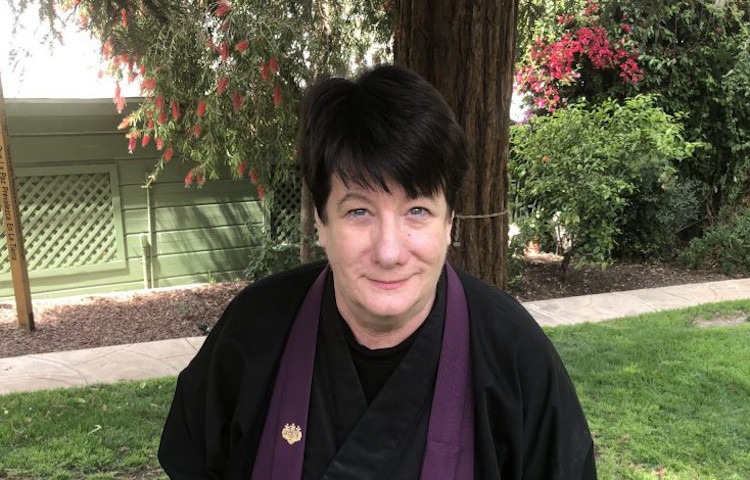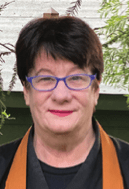
A House Un-Divided
April 1, 2023
 by Katherine Senshin Griffith
by Katherine Senshin Griffith
“If we could first know where we are, and whither we are tending, we could then better judge what to do, and how to do it… ‘A house divided against itself cannot stand.’ I believe this government cannot endure, permanently half slave and half free.” – Abraham Lincoln, June 1858
As Buddhists we wish all beings to be free—free from the greed, anger and ignorance that causes suffering. We vow tO awaken to our True Nature of interdependence and the co-arising of all things. We wish to think of our country as united but see continual evidence that we are still very divided. The so-called United States was founded on the genocide of numerous indigenous peoples, and the forced labor of enslaved Africans. To delve deeper into this “house divided” from a Buddhist perspective, let’s examine Mumonkan Case 35, “Seijo and Her Soul are Separated. Goso said to his monks, “Seijo’s soul separated from her being. Which was the real Seijo?”
This koan comes from a famous Chinese folktale of the T’ang period. Once upon a time, Chōkan loved his beautiful daughter Sei very much. (Sei is a proper name and jo means girl.) When Sei was little, Chōkan teased her, saying she and her handsome cousin Ochu would make a fine married couple. The two cousins grew up and fell in love and were devastated when Chōkan announced Sei’s engagement to another man. Heartbroken, Ochu set off in a boat till Sei called to him from the riverbank. They ran away together and eventually had two kids. But they both longed to return home and get her father’s blessing.
Leaving Sei in the boat, Ochu went to see Chōkan and apologized for running away with Sei. Chōkan was dumbfounded. “My daughter Sei has been in a coma since the day you left.” Chōkan showed him the sickly Sei in bed.
Ochu said, “This can’t be, Sei is in my boat right now.” Chōkan’s servant then confirmed Sei was on the boat. Chōkan told the whole story to the sick Sei who silently got out of bed just as the other Sei arrived at the house and the two Seijos became one. Sei then said, “I didn’t know I was in a coma. When I heard Ochu ran away, I followed his boat as if in a dream. I’m not sure which was the real me: the one sick in bed, or the wife and mother.”
Now, Master Goso is not asking us to solve this folk tale mystery but to open up our penetrating Zen eye and see our true nature clearly, as Master Mumon comments:
When you realize what the real is, you will see that we pass from one husk to another like travelers stopping for a night’s lodging. But if you do not realize it yet, I earnestly advise you not to rush about wildly. When earth, water, fire, and air suddenly separate, you will be like a crab struggling in boiling water with its seven or eight arms and legs. When that happens, don’t say I didn’t warn you.
One of the points of the tale is that we humans play various roles in life and relate differently to different peo- ple in different situations. Who is the Real Self underlying and taking on these roles? These roles are more like guests and hosts of the Real Self. Even our personalities are more servants than masters of the Mind.
Someone told me recently he didn’t know who he was, who I was, who anyone was. How wonderful! There’s so much to endlessly discover. How audacious to think we completely KNOW anything!
Who is the Real United States? I’d like to look at a collective approach to this fundamental question. The great inventor Buckminster Fuller said, “We are not going to be able to operate our Spaceship Earth successfully nor for much longer unless we see it as a whole spaceship and our fate as common. It has to be everybody or nobody.”
What’s the difference between diversity and division? Can we have diversity without division? We aspire to “one nation, indivisible, with liberty and justice for all.” But
our nation’s soul is separated. One aspect is full of greed, hatred and delusion; the other believes in liberty and justice for everyone. Who is the Real United States? Both these aspects are in each of us. It’s a delusion to think that these qualities only apply to certain people. Could this be another folktale?
Once upon a time there was a beautiful country. It was told in its early years that it was betrothed to liberty and justice for all. But then its founding fathers wanted to marry it off to greed, anger, and ignorance – consumerism, genocide, oppression. One side pulled away from that and vowed to be awake to its underside in the pursuit of liberty and justice. But the other side stayed sick in a coma of delusive harmful behavior. Who is the Real United States?
These two karmic tributaries flow through each of us – whether we recognize it or not. Witnessing the repercussions of our sense of separation is painful. We may “pass from one husk to another” thinking we are free from blame but there is only the One True Body.
Will this nation – or any for that matter – unite into the One Body – even with all its differences? The House Un-Divided that it already is—and cannot be otherwise. Can a Nation realize its True Self? Are we not a part of that process? Doesn’t it take each of us realizing our Essential Nature?
Buckminster Fuller also said: “You never change things by fighting the existing reality. To change something, build a new model that makes the existing model obsolete. You cannot change how someone thinks, but you can give them a tool to use which will lead them to think differently.”
We are fortunate to have the tools of our Zen Practice. As a Sangha, we have subtle, myriad differences. But we also have a common renewed intention to be beneficial, fortified by the practices of zazen, council, atonement, working together and the Three Tenets. Not Knowing, atoning, deep listening and working together is exactly what is needed in our divided house – both individually and collectively.
The aspirational United States is often referred to as
a great democratic experiment and we truly are a work-in-progress. The global task of peacemaking, reconciliation, mutual recognition, and justice is an unending process that takes boundless patience, deep listening and dropping preconceptions. But isn’t that what we as Zen students commit to with our Great Bodhisattva Vows?
Starting with ourselves: What is inside your own house of the mind that is divided? Are you one with what you are doing? Or are you always wishing you were someplace else? Are you torn between the different aspects of your life or roles you are asked to take on? What is keeping you from full commitment to your zazen?
We can find ourselves in situations where we construct narratives about ourselves. Often others seem to construct an image of us that is different than how we see ourselves. This is true of nations and individuals. If we over identify with one aspect, we can lose the rest of our potential or be blind to areas that need to be dealt with. We can experience conflicts between our different roles and those of others too. We can forget the ripples are all part of the Great Ocean.
Mumon’s verse on this koan:
The moon above the clouds is ever the same;
Valleys and mountains are separate from each other. How wonderful! How blessed!
Is this one or is this two?
Feeling separated from ourselves can reveal not just a big yearning to fully express our gifts but a deep longing to know our True Self. We may feel something in us is not whole – but sense there is a Whole. To close the gap and experience our Real Self, we must personally shed all concepts, expectations and surface answers.
Another master Huo-an wrote a verse on Seijo’s koan:
Whatever done is not forgotten.
Even in thousands of years:
When causes and conditions combine,
Results and consequences are naturally experienced.
We may be experiencing the consequences of the harmful deluded side of ourselves. Knowing that our individual awakening affects not just our own lives but the greater House Un-Divided, can inspire full-hearted commitment to practice.
Sensei Senshin is the ZCLA Head Teacher.
